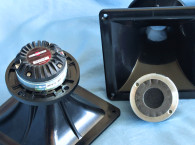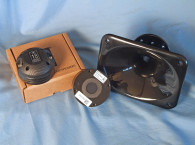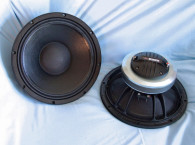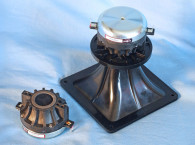Previously, Voice Coil featured two Eighteen Sound 1.4” compression drivers, the NSD1424BTN with the XT1464 horn in the May 2021 issue, and the ND2T combined with the Eighteen Sound XT1464 elliptical-shaped horn in the October, 2021 issue. Now, the company sent a 1” throat compression driver, the NSD1095N, which I paired with the Eighteen Sound XT120 (Photo 1).

Designed for use with 1” throat horns, the compact footprint NSD1095N (93mm diameter) is presented as a compression driver to use where “high quality” sound is required (e.g., in studio monitors or stage monitors). The Eighteen Sound NSD1095N compression driver has a 1” (25mm) throat diameter driven by a 44mm (1.75”) diameter edge-wound voice coil wound with copper-clad aluminum wire (CCAW) on a non-conducting Nomex former with a proprietary treatment. This specially treated Nomex former shows a 30% higher value of tensile elongation at operating temperatures (200°C) when compared to Kapton.
This assembly drives the field replaceable True Piston Motion (TPM) TiN coated titanium diaphragm. TPM technology is the Eighteen Sound acronym for its nitride-coated titanium process developed after extensive research by Eighteen Sound. The coating is applied to the titanium diaphragm in a Physical Vapor Deposition (PVD) vacuum chamber. With its very high value of elasticity modulus (six times higher than titanium and two times higher than beryllium), the nitride thin film is capable of doubling the diaphragm overall stiffness with obvious benefits in terms of impulse response and intermodulation distortion reduction. The frequency response is also extended by 25%, showing a predictable, ideal pistonic behavior, avoiding top-end spurious resonances.
The NSD1095N also incorporates a proprietary phase plug architecture that has been designed to give a smooth coherent wavefront at the horn entrance across the whole working frequency range. The phase plug short openings and high flare rate value assure low distortion and overall, this kind of phase plug, according to Eighteen Sound, demonstrates remarkable improvements in mid-high frequency reproduction.
Other features include a computer optimized neodymium ring magnet motor structure, copper pole piece shorting ring (Faraday shield) a continuous power handling of 100W, a 1.6kHz recommended crossover frequency (with a minimum 12dB/octave high-pass network), corrosion-resistant black emissive coating on the magnets and plates, plus a black emissive coated array of heatsink fins on the rear cover, a 2.83V/1m 110.0dB sensitivity, plus standard solderable terminals.
Along with the NSD1095N, I used the Eighteen Sound 1” throat XT120 90° × 60° elliptical constant directivity horn with a 1500Hz cut-off frequency. FEA-computer designed and made from high pressure die cast polyurethane foam, the XT120 has a smooth flare rate that provides a low distortion spherical wave-front and constant directivity from 2.5kHz. Figure 1 and Figure 2 give the horizontal and vertical plane polar maps (directivity spectrograms), respectively for the XT120 horn.
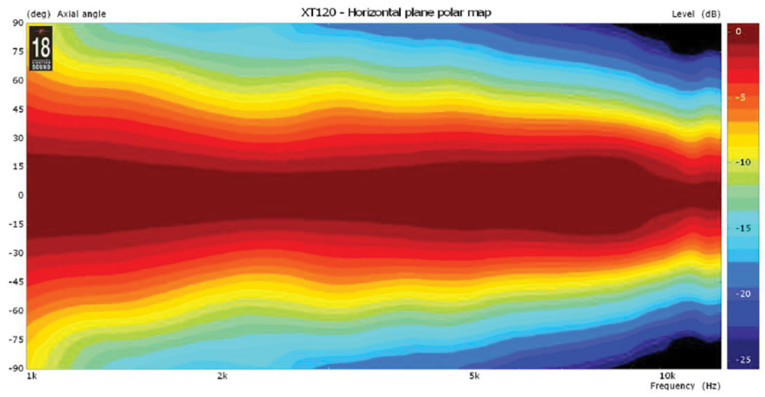

Testing began using the LinearX LMS analyzer to produce the 300-point stepped sine wave impedance plot shown in Figure 3, with the solid black curve showing the NSD1095N mounted on the XT120 horn and the dashed blue curve representing the compression driver without the horn. With nominal 8Ω impedance, the NSD1095N has a 5.26Ω DCR, with minimum impedance mounted on the XT120 horn of 6.4Ω and at 6.07kHz.

For the first group of SPL measurements, I free-air mounted the NSD1095N/XT120 combination without an enclosure and measured both the horizontal on- and off-axis at 2.0V/0.5m (normalized to 2.83V/1m) from 0° on-axis to 60° off-axis using the Loudsoft FINE R+D analyzer and GRAS 46BE microphone (supplied courtesy of Loudsoft and GRAS Sound & Vibration).
Figure 4 displays the on-axis frequency response of the compression driver/horn, which shows a smooth ±2dB response from 1.5kHz to 6kHz, above which you see the constant directivity response of the horn. Figure 5 depicts the 0° to 60° on- and off-axis response in the horizontal plane with Figure 6 illustrating the normalized horizontal plane response. Figure 7 shows the 180° horizontal polar plot (in 10° increments with 1/3 octave smoothing applied) generated by the CLIO Pocket analyzer and accompanying microphone (courtesy of Audiomatica SRL).

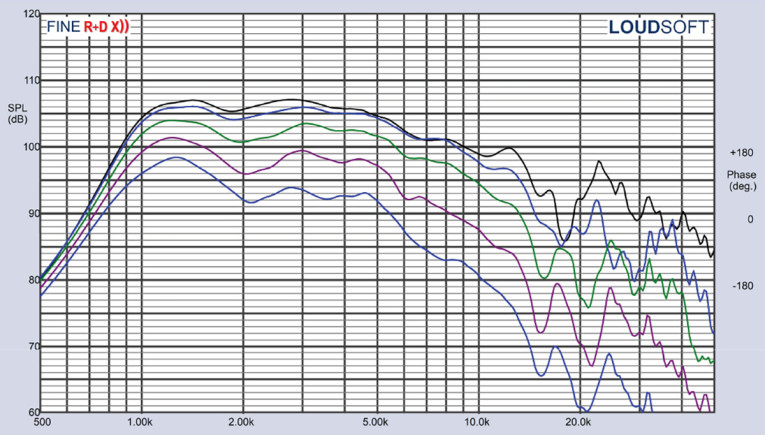

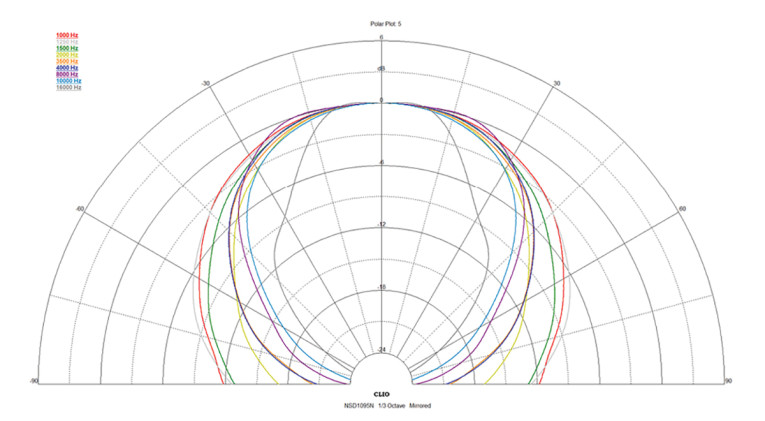
For the vertical plane, Figure 8 illustrates the 0° to 60° on- and off-axis response in the vertical plane with Figure 9 depicting the normalized vertical plane response. Figure 10 shows the 180° vertical polar plot (in 10° increments with 1/3 octave smoothing applied), generated by the CLIO Pocket analyzer and accompanying microphone. Last, Figure 11 depicts the two-sample SPL comparison showing the two Eighteen Sound NSD1095N/XT120 compression driver samples to be closely matched within 0.5dB to 1.0dB or less throughout the driver’s operating range.

Figure 8: Eighteen Sound NSD1095N 0° to 60° on- and off-axis response in the vertical plane
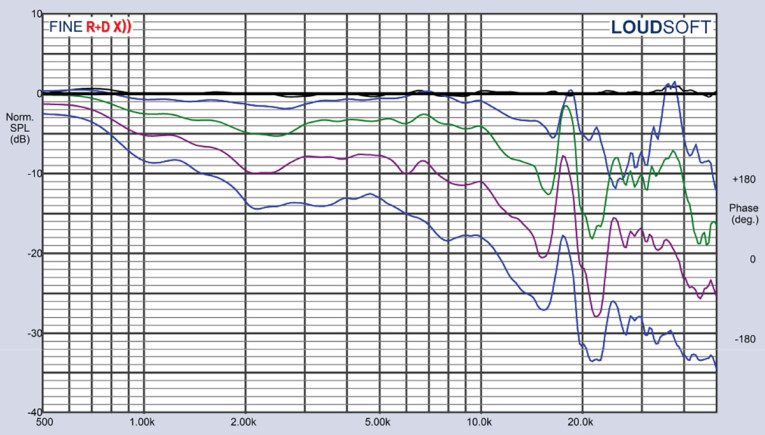


For the remaining sequence of tests, I set up the Listen, Inc. AudioConnect analyzer and 1/4” SCM microphone (provided courtesy of Listen, Inc.) to measure distortion and generate time-frequency plots. For the distortion measurement, I mounted the NSD1095N/XT120 combination in free-air and set the SPL to 104dB at 1m (2.27V), determined by using a pink noise stimulus generator and internal SLM in the SoundCheck V18 software.
I then measured the distortion with the Listen microphone placed 10cm from the mouth of the horn. This produced the distortion curves shown in Figure 12, exhibiting very low third-harmonic content.

After completing this test protocol, I set up SoundCheck 18 to generate a 2.83V/1m impulse response curve for this driver/horn and imported the data into Listen’s SoundMap Time/Frequency software. Figure 13 shows the resulting cumulative spectral decay (CSD) waterfall plot. Figure 14 shows the Short Time Fourier Transform (STFT) plot.
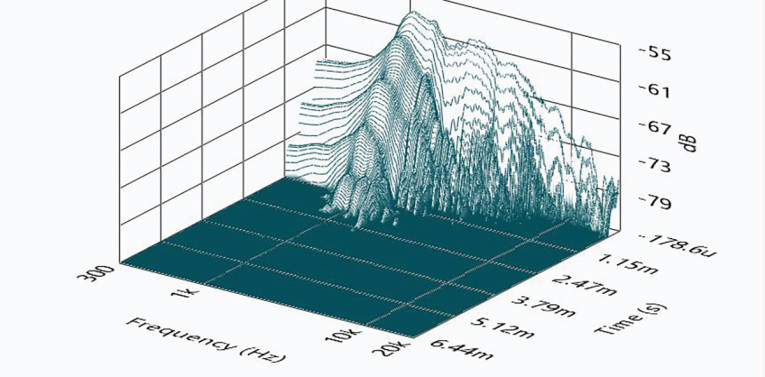

Taking into consideration all the objective measurement data, the Eighteen Sound NSD1095N compression driver is clearly a well-engineered 1” compression driver, exhibiting good performance, outstanding build quality, and featuring a number of proprietary features (TiN-coated Titanium diaphragm, phase plug, and Nomex former coating), all typical of a high-profile pro sound OEM such as Eighteen Sound. For more information, visit www.eighteensound.com. VC
This article was originally published in Voice Coil, March 2022.




